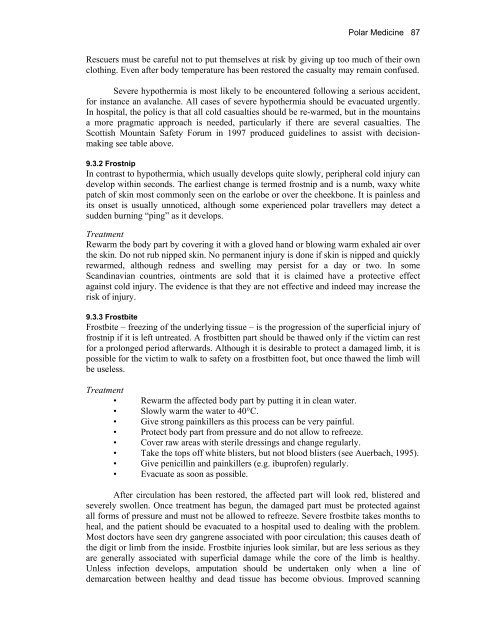Edited by Rachel Duncan 4th Edition ISBN 0-907649-91-2 London ...
Edited by Rachel Duncan 4th Edition ISBN 0-907649-91-2 London ...
Edited by Rachel Duncan 4th Edition ISBN 0-907649-91-2 London ...
Create successful ePaper yourself
Turn your PDF publications into a flip-book with our unique Google optimized e-Paper software.
Polar Medicine 87<br />
Rescuers must be careful not to put themselves at risk <strong>by</strong> giving up too much of their own<br />
clothing. Even after body temperature has been restored the casualty may remain confused.<br />
Severe hypothermia is most likely to be encountered following a serious accident,<br />
for instance an avalanche. All cases of severe hypothermia should be evacuated urgently.<br />
In hospital, the policy is that all cold casualties should be re-warmed, but in the mountains<br />
a more pragmatic approach is needed, particularly if there are several casualties. The<br />
Scottish Mountain Safety Forum in 1997 produced guidelines to assist with decisionmaking<br />
see table above.<br />
9.3.2 Frostnip<br />
In contrast to hypothermia, which usually develops quite slowly, peripheral cold injury can<br />
develop within seconds. The earliest change is termed frostnip and is a numb, waxy white<br />
patch of skin most commonly seen on the earlobe or over the cheekbone. It is painless and<br />
its onset is usually unnoticed, although some experienced polar travellers may detect a<br />
sudden burning “ping” as it develops.<br />
Treatment<br />
Rewarm the body part <strong>by</strong> covering it with a gloved hand or blowing warm exhaled air over<br />
the skin. Do not rub nipped skin. No permanent injury is done if skin is nipped and quickly<br />
rewarmed, although redness and swelling may persist for a day or two. In some<br />
Scandinavian countries, ointments are sold that it is claimed have a protective effect<br />
against cold injury. The evidence is that they are not effective and indeed may increase the<br />
risk of injury.<br />
9.3.3 Frostbite<br />
Frostbite – freezing of the underlying tissue – is the progression of the superficial injury of<br />
frostnip if it is left untreated. A frostbitten part should be thawed only if the victim can rest<br />
for a prolonged period afterwards. Although it is desirable to protect a damaged limb, it is<br />
possible for the victim to walk to safety on a frostbitten foot, but once thawed the limb will<br />
be useless.<br />
Treatment<br />
• Rewarm the affected body part <strong>by</strong> putting it in clean water.<br />
• Slowly warm the water to 40°C.<br />
• Give strong painkillers as this process can be very painful.<br />
• Protect body part from pressure and do not allow to refreeze.<br />
• Cover raw areas with sterile dressings and change regularly.<br />
• Take the tops off white blisters, but not blood blisters (see Auerbach, 1995).<br />
• Give penicillin and painkillers (e.g. ibuprofen) regularly.<br />
• Evacuate as soon as possible.<br />
After circulation has been restored, the affected part will look red, blistered and<br />
severely swollen. Once treatment has begun, the damaged part must be protected against<br />
all forms of pressure and must not be allowed to refreeze. Severe frostbite takes months to<br />
heal, and the patient should be evacuated to a hospital used to dealing with the problem.<br />
Most doctors have seen dry gangrene associated with poor circulation; this causes death of<br />
the digit or limb from the inside. Frostbite injuries look similar, but are less serious as they<br />
are generally associated with superficial damage while the core of the limb is healthy.<br />
Unless infection develops, amputation should be undertaken only when a line of<br />
demarcation between healthy and dead tissue has become obvious. Improved scanning

















